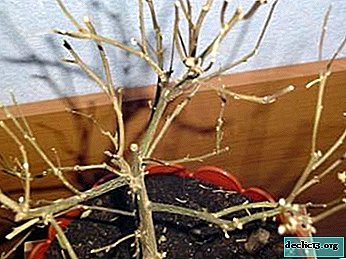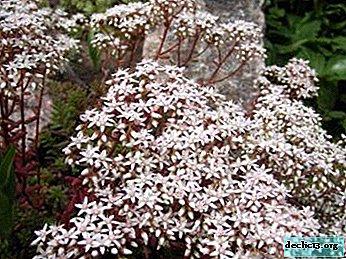Why did the lemon have fallen leaves and what to do to save the plant?

Caring for homemade lemon is not as easy as it seems. It is necessary to observe certain rules of care so that the fragrant handsome man is healthy, actively blossoms and bears fruit.
With improper care, a long and complex resuscitation of the plant may be required. It is very important to help your lemon as soon as possible.
In our article, you will find out why this happens and what to do next, as well as what pests are dangerous for lemon and what diseases can destroy it.
Why did the leaves of a houseplant fall off and what to do about it?
Caring for citrus in a home environment is quite difficult. If the plant has dropped leaves, do not be very upset. It is necessary to find out why this happened and take measures to improve it. There are a number of reasons why a tree can lose all its leaves.
Leaf dumping is the result of violation of the rules of care and maintenance. We will analyze the most frequently made mistakes when caring for the plant and measures to correct them.

- Bay plants. What to do for resuscitation of a plant? The main features of a lemon bay are yellow leaves from the base to the edge and constantly moist soil in the pot. The tree begins to wither from the top, sluggish leaves fall, the root system slows down, the thermoregulation of the whole plant is disrupted.
How to revive it? The most effective way in this case is an emergency transplant. But if most of the leaves are healthy and hold tight, the top of the head has not wilted and it is winter outside - you can not transplant the lemon. The roots of the plant need to provide air exchange.
It is necessary to loosen and pierce the earth with a thin stick, increase the drainage holes in the pot. Move the tree to a warm, dry room, this will help dry the earthball.
- Acclimatization after purchase. What to do for resuscitation of a plant? When changing the habitat and the usual climate from a store or a greenhouse to an ordinary apartment, citrus fruits can lose their leaves. The conditions of the apartment are not ideal for them, far from natural.
During the acclimatization period, the lemon should be placed in the brightest, warmest place without drafts near the humidifier and the backlight in the evening. Once every 2-3 days, the tree needs to be sprayed.
Old leaves will gradually fall off due to the large amount of stimulants that were added at the production site. - Drafts. What to do for resuscitation of a plant? Despite the fact that the room should be well ventilated, the lemon does not tolerate drafts and can instantly be offended and discard the foliage. The plant should be placed away from windows and entrance doors, a gas stove and ventilation.
- Stress as a result of a change of place. What to do for resuscitation of a plant? It is very important for a citrus bush to grow in one place. He does not like moving around the apartment reacting negatively to this. He began to dry twigs and fall leaves. Follow the rules of watering, regularly spray the crown without getting on the flowers.
- Pot size too large. What to do for resuscitation of a plant? A common mistake of beginner gardeners is - not choosing the right pot for the plant. If the pot is too large, a lot of excess water gets in, the plant does not have time to consume it. Overmoistening of the soil occurs.
Also, the tree will actively grow roots to occupy the free space of the earth and not grow externally. If it’s recommended to transplant the lemon into a pot of the size of a fresh, nutritious citrus soil in the spring outside. In winter, the plant is difficult to adapt after transplantation.
- Abundant watering after a long drought. What to do for resuscitation of a plant? If the plant is not watered for a long time, and then it is liberally moistened, all leaves, even healthy ones, may fall. As a result of prolonged drought, some of the roots dry out and there is nothing for the tree to absorb in excess water. The roots that could still be saved in this case rot.
Around lemon is resuscitated gradually. Start with spraying water on the leaves and topsoil. Day after day, the amount of moisture is increased. It is the gradual addition of water and humidity in the room that will help restore fallen leaves without stress for the tree.
- Watering the plants with too cold water. What to do for resuscitation of a plant ?. From cold water and air, the plant experiences stress and discards leaves. Lemon needs to provide a comfortable place to stay. Normalize proper watering. Pour settled water at room temperature as necessary.
Disease
Improper care of the plant provokes a weakening of the immune system and numerous diseases. Because of this, the tree loses its attractive appearance, the leaves turn yellow, become stained, fly around, and the roots rot.Massive and sharp falling of leaves occurs when: non-observance of the growing technology and damage to the tree by diseases such as root rot and gummosis.

- Gummosis (How does the problem appear externally and what should be done to correct the situation?). Gommosis is an infectious disease. The bark of the tree turns brown, it cracks heavily, gum stands out.
The crack increases and decays over time, the tree may die. If the plant becomes sick, it is necessary to clean the wound to a healthy tissue and disinfect it with 3% solution of iron or copper sulfate, then treat it with garden var. The best treatment is prevention and maintenance of lemon in favorable conditions.
- Root rot (How does the problem appear externally and what should be done to correct the situation?). The disease manifests itself through a massive discharge of foliage and the absence of external signs of lesions. Rarely, stains with a damp substance may appear on the tree trunk. The disease appears due to waterlogging of the soil.
In rare cases, when the root system is infected through wounds received during plant transplantation or damage by pests. Having discovered rot, diseased roots are completely removed. Places of cuts are treated with charcoal or activated carbon.
Old soil is replaced with fresh special soil for citrus. After transplanting, the plant is not watered for 5-7 days. Regularly spray foliage. To prevent root rot, lemon can be watered with water and ash.
Pests
A common cause of poor citrus status is pests. They ruthlessly suck the juice from the plant, taking useful nutrients. Typically, citrus may be attacked by a spider mite, scutellum, or aphid. As a result of severe pest damage, the leaves may fall, but this does not happen abruptly and simultaneously.
However, danger may be:
- Spider mites, citrus mites and Hume tick. If the lemon actively blossomed and abruptly dropped the leaves, and a spider web is visible on the branches, this indicates an attack of insects or spiders. The main symptom of parasitic ticks is the web on the inside of the leaves.
Ticks are disposed of immediately. It is necessary to purchase means of directed action. The safest plants for health are sprays with a solution of sulfur or mineral oil.
- Scale and false shields. The scabbard eats the juice of the plant, leaving small dark yellow holes resembling plaque on the leaves. Because of this, the foliage falls, and the tree becomes infected with the infection. Pests live in colonies and quickly migrate to neighboring plants, so the fight against them begins immediately.
If dark yellow spots are found in the form of growths on the leaves, it is necessary to check the absence of neoplasms on the branches of the tree. If available, remove growths and affected leaves. Wipe healthy foliage with an alcohol-containing solution.
Spray the tree with an insecticide. The procedure must be repeated until the symptoms disappear completely.
- Aphids and thrips. Aphids settle on young succulent leaves, clinging to the inside of the leaf. It affects the plant by sucking juice from young shoots, slowing its development. Citrus leaves fall, young shoots dry. Insect about 0.5 mm in size, light green.
Due to its color, it is difficult to notice and take appropriate measures. The most radical way to combat are industrial chemicals of wide action. From folk remedies, wood ash is good at fighting aphids. It is sprayed on the leaves of plants or mixed with a soapy solution and washed whole tree.
In any emergency, to preserve the lemon tree and restore its crown, it is necessary to create conditions of high humidity. In such an environment, it is easier for a lemon to gain strength and improve health. In summer, lemon can be taken out to the balcony. Proper care brings joy and pleasure.
Useful video
The video tells why the lemon leaves fall and how to help the plant:

















